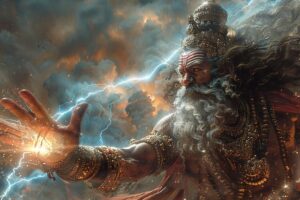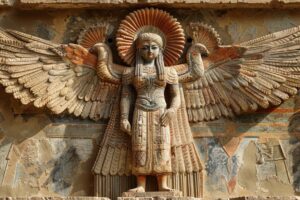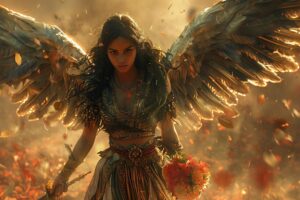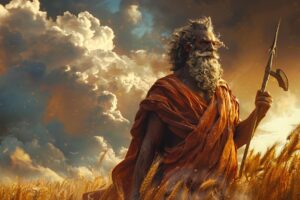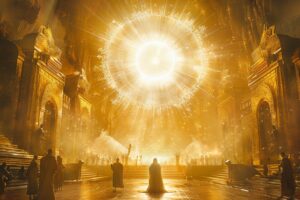Hannahanna Goddess Hittites: Origins, Myths, and Cultural Impact

Hannahanna, also known as the “Great Mother,” is a central figure in Hittite mythology. Her name means “grandmother” and signifies her revered status as the matriarch of the gods.
She is depicted as both nurturing and temperamental. Key myths involving Hannahanna include the disappearance of the god Telepinu and her own temporary vanishing, both of which led to chaos before order was restored.
Origins and Name
The origins and meanings of Hannahanna in Hittite mythology reflect her ancestral significance and revered status among the deities.
Meaning of the Name Hannahanna
The name Hannahanna is derived from the Hittite term ‘hanna’, which means ‘grandmother’. This translation emphasizes both her ancient and venerated role within the pantheon.
Literally translated, Hannahanna can be understood as ‘the grandmother-grandmother’.
This term is a mark of deep respect, highlighting her position as a matriarch both in the divine hierarchy and in mythological narratives.
Ancestral Role in Hittite Mythology
As the Great Mother, Hannahanna holds a principal position among the gods. Her character encapsulates the duality of being nurturing and temperamental, embodying the complexities of a maternal figure who also administers justice and order.
Numerous myths emphasize her crucial role in maintaining cosmic balance. By intervening in disputes and conflicts among deities, she ensures that harmony is restored. Her actions often involve mediation and corrective measures, reflecting her significant influence.
In several mythological accounts, she actively resolves crises that threaten the natural and divine order. These actions solidify her role as a protector and mediator, contributing to her widespread veneration and lasting legacy in Hittite culture.
Roles and Attributes
Hannahanna is renowned for her multifaceted roles and various attributes in Hittite mythology.
Maternal Characteristics
Hannahanna is primarily recognized for her maternal attributes. As the Great Mother of the gods, she embodies nurturing and protective qualities. Her actions in mythological tales frequently emphasize her role in safeguarding her divine offspring and ensuring their well-being.
She is often portrayed as a figure who goes to great lengths to provide care and intervention when needed. Her involvement in the myth of Telepinu, where she attempts to restore order and vitality, highlights her nurturing nature.
Hannahanna’s maternal instincts drive her to resolve crises that impact both the divine and mortal realms.
Temperamental Nature
Despite her nurturing role, Hannahanna is also depicted as having a temperamental nature. This duality adds complexity to her character. While she can be caring and protective, she is equally capable of displaying anger and severity.
This temperament is evident in the myth where Hannahanna herself disappears in a fit of rage. Her absence leads to widespread chaos, illustrating the profound impact of her emotional state on the natural and cosmic order.
Such stories underscore the fierce and sometimes unpredictable aspects of her personality.
Protector and Mediator
As a protector and mediator, Hannahanna plays a crucial role in resolving conflicts and restoring harmony. She often steps in to mediate disputes among gods and address issues affecting the world.
In the myth of Telepinu, Hannahanna’s intervention involves sending a bee to locate and rejuvenate the missing deity. This act of mediation not only helps resolve the crisis but also reaffirms her role as a problem solver and peacemaker.
Her wisdom and strategic thinking position her as a key figure in maintaining balance within the pantheon and the human world.
Hannahanna’s abilities to protect and mediate are not limited to divine conflicts.
She is also involved in domestic matters, such as advising on marriages and ensuring the continuation of familial and social order. This protective role is echoed in various rituals and ceremonies in Hittite culture that honor and invoke her presence.
Major Myths Involving Hannahanna
The central role of Hannahanna in Hittite mythology is demonstrated through several major myths, underscoring her importance in divine and natural order.
The Myth of Telepinu
Telepinu’s Disappearance
The myth begins with the disappearance of the god Telepinu, whose sudden absence plunges the world into chaos. Telepinu’s departure leads to the withering of crops and a halt in all natural growth.
His father, the storm god Tarhunna, becomes desperate to find him and restore balance.
Intervention and Strategy
When Tarhunna’s efforts to locate Telepinu fail, he turns to Hannahanna for help. As a mediator and figure of wisdom, Hannahanna formulates a plan. She advises Tarhunna to calm his search efforts and instead sends others to find Telepinu.
Role of the Bee
Hannahanna sends a bee to search for Telepinu. The bee’s role is pivotal, as it not only finds Telepinu in his hiding place but also revives him. The bee stings Telepinu’s hands and feet, removing the cause of his anger and allowing him to return to his duties.
This act symbolizes purification and rejuvenation.
Restoration of Order
With Telepinu’s return, order is restored. The natural world begins to thrive once again, crops grow, and balance is returned to both the divine and mortal realms. Hannahanna’s intervention highlights her power in resolving crises and restoring harmony.
The Disappearance of Inara
Initial Problem
The myth centers on the disappearance of the goddess Inara, another significant deity in Hittite lore. Inara’s absence is troubling, leading to concerns among the gods.
Search Efforts
Upon learning of Inara’s vanishing, Hannahanna initiates a search. She collaborates with her assistant and employs various strategies to locate Inara, demonstrating her determination and problem-solving abilities.
Resolution
Hannahanna’s persistent efforts eventually lead to the recovery of Inara. This successful search underscores Hannahanna’s role as a protector and resolver of divine issues. Her actions prevent potential chaos that could arise from Inara’s absence.
The Disappearance of Hannahanna
Impact of Her Anger
In another myth, Hannahanna herself vanishes due to a fit of anger. Her disappearance causes significant disruption. Livestock stop reproducing, and both human and animal mothers abandon their offspring, highlighting the severe impact of her absence.
Restoration of Normalcy
The chaotic state continues until Hannahanna’s anger subsides. Her return brings a swift restoration of normalcy. Life resumes its natural course, and the nurturing cycles recommence. This myth portrays the dual aspects of Hannahanna’s influence—both her destructive potential and her restorative power.
Role in Agricultural Cycles
Hannahanna’s role in agricultural cycles is emphasized in this myth. Her anger and subsequent disappearance directly affect the fertility and productivity of the land. This cycle underscores her integral connection to natural processes and the well-being of the Hittite people.
Analysis of Sources
An in-depth analysis of various sources reveals significant insights into the figure of Hannahanna in Hittite mythology. This section explores different perspectives from recognized institutions and academic research.
Brooklyn Museum Insights
The Brooklyn Museum offers a comprehensive overview of Hannahanna’s role in Hittite mythology.
Detailed context is provided regarding her status as a maternal and conflict-resolving deity. The museum also discusses Hannahanna’s symbolic representation and her influence on Hittite society. Additionally, the museum highlights her inclusion in modern artistic installations that celebrate influential mythological figures.
Academic Research
Books and Publications
Several scholarly works provide detailed accounts of Hannahanna’s mythology. Noteworthy books include H. A. Hoffner’s ‘Hittite Myths’, which presents translated fragments of significant myths involving Hannahanna. Josepha Sherman’s ‘Storytelling: An Encyclopedia of Mythology and Folklore’ also delves into the narratives of Hannahanna, offering an encyclopedic perspective on her stories and roles.
Authors like H. Otten discuss the etymology and broader cultural implications of Hannahanna in works such as ‘Reallexikon der Assyriologie und vorderasiatischen Archäologie’. These texts offer academic rigor and a broad perspective on the differing myths and roles attributed to Hannahanna.
Encyclopedias and Specialized Works
Numerous encyclopedias and specialized works contribute to the scholarly understanding of Hannahanna. Resources such as P. Taracha’s ‘Religions of Second Millennium Anatolia’ provide an in-depth look at the religious context of Hannahanna within the broader framework of Hittite worship practices.
These works analyze her influence on ritualistic ceremonies and societal norms.
Additionally, encyclopedic entries highlight Hannahanna’s relationships with other deities, her function in mythological narratives, and the socio-religious implications of her actions.
Such resources help piece together a more comprehensive picture of her impact on Hittite civilization.
Cultural Significance in Hittite Society
Hannahanna’s influence permeated many aspects of Hittite life and culture, reflecting her vital role as a deity.
Ceremonies and Rituals
Ceremonies dedicated to Hannahanna were central to Hittite religious practices. These rituals emphasized her role in fertility, agriculture, and the well-being of the community. Festivities often included offerings of food and drink, as well as symbolic acts aimed at invoking her favor and ensuring prosperity.
The rituals also involved the participation of various members of the society, from priests to commoners, underscoring the communal reverence for Hannahanna. Seasonal festivals, particularly those aligned with agricultural cycles, frequently honored her, acknowledging her influence over the natural world and its productivity.
Symbolic Representation in Society
Hannahanna was symbolically represented in various forms throughout Hittite society. Artifacts and iconography depicting her often featured maternal symbols or elements that highlighted her dual nature of protection and sternness.
Temples and shrines dedicated to her were decorated with motifs reflecting her significance, including representations of the bee from the myth of Telepinu.
These symbols served as reminders of her omnipresence and the need for balance and respect toward the forces she embodied.
The presence of her imagery in both private homes and public spaces indicates her widespread veneration and cultural importance.
Influence on Hittite Culture and Traditions
Hannahanna’s myths and characteristics deeply influenced Hittite culture and traditions. Her stories, passed down through generations, shaped societal norms and values regarding motherhood, conflict resolution, and the natural order. Hannahanna’s intervention in divine and human affairs reinforced the idea that both the gods and humans relied on her wisdom and power to maintain harmony.
Traditional practices centered around her teachings and actions, promoting values such as nurturing care and disciplined action. The mythological narratives involving her disappearance and return played a vital role in explaining natural phenomena and agricultural challenges, embedding her influence in the very foundation of Hittite existence.
Impact and Legacy
The influence of Hannahanna extends beyond ancient mythology, permeating modern scholarly research, artistic installations, and ongoing cultural relevance.
Interest in Modern Scholarship
Researchers continue to delve into Hannahanna’s myths and roles, seeking to understand her significance in Hittite society.
Several academic disciplines focus on different aspects:
- Anthropologists study her role in Hittite culture and rituals.
- Historians analyze ancient texts to comprehend her influence on societal norms.
- Mythologists compare her to goddesses in other ancient civilizations.
There are numerous publications dedicated to her mythology, offering insights into how she shaped the beliefs and practices of the Hittites.
Books like “Hittite Myths” by H.A. Hoffner and encyclopedic entries provide detailed explorations of her stories and their implications.
Representation in Artistic Installations
Hannahanna’s legacy is evident in various artistic mediums, showcasing her enduring influence.
Dinner Party Exhibit
The Brooklyn Museum’s “Dinner Party” installation includes her as a significant female figure, celebrating her impact alongside other influential women. This artwork bridges ancient mythology and contemporary reflections on gender and power.
Modern Artworks
Artists inspired by ancient myths frequently incorporate Hannahanna in their works, portraying her attributes and legendary deeds through paintings, sculptures, and digital art. These representations often emphasize her dual nature as both a nurturing mother and a powerful, temperamental force.
Ongoing Relevance
The relevance of Hannahanna endures in contemporary discussions about mythology, culture, and gender roles.
Her character continues to inspire:
- Scholarly debates about the role of maternal figures in mythologies.
- Literature and media focusing on ancient goddesses and their modern interpretations.
- Educational programs and curriculums aiming to highlight significant mythological figures across cultures.
Hannahanna’s stories remain a valuable resource, offering insights into the complexities of divine intervention, familial roles, and the human condition.
Frequently Asked Questions
The following section addresses common questions about Hannahanna, shedding light on her essential role and representation in Hittite mythology.
Who was Hannahanna?
Hannahanna is known as the ‘Great Mother’ of the gods in Hittite mythology. Revered as an ancestral figure, her name translates to ‘grandmother’ in the Hittite language. She plays a vital role in resolving divine conflicts and maintaining cosmic balance.
What are the main myths involving Hannahanna?
The Myth of Telepinu
One of the most prominent myths involving Hannahanna is the story of Telepinu, the god of agriculture. This myth highlights her intervention in finding Telepinu when he disappears, causing chaos in the natural world.
The Disappearance of Inara
Another significant myth is the disappearance of Inara, where Hannahanna actively participates in the search for the missing goddess, assisted by her female aide. This story underscores her determination and involvement in divine affairs.
The Disappearance of Hannahanna
In a myth where Hannahanna herself disappears, her absence results in severe disruptions. The myth emphasizes the impact of her anger and the eventual restoration of normalcy when she returns, highlighting her critical connection to agricultural cycles.
How did Hannahanna contribute to resolving conflicts?
Hannahanna is portrayed as a skilled mediator and problem solver. In the Myth of Telepinu, she directs both the storm god Tarhunna and a bee to find and revive Telepinu, successfully restoring order.
Her interventions often involve practical and strategic approaches to complex situations.
What is the significance of the bee in the myth of Telepinu?
In the Telepinu myth, the bee plays a crucial role in locating and revitalizing the missing god. Sent by Hannahanna, the bee stings Telepinu to wake him and anoints his eyes and feet with wax, purifying and re-energizing him.
This act not only brings back Telepinu but also revitalizes the natural world.
How is Hannahanna represented in modern culture?
Hannahanna’s legacy continues to be of interest in modern scholarship and artistic representations. She is featured in various academic studies, museum exhibits, and artistic installations, celebrating her mythological importance and influence.













